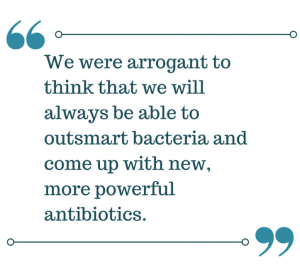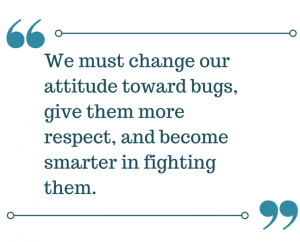Expert Spotlight: Five Questions with Dr. Evgeni Sokurenko
Bacteria are becoming increasingly invincible against even our strongest antibiotics, costing tens of thousands of lives and billions in unnecessary healthcare costs annually. While lots of attention has been placed on the need for the development of new, stronger drugs, antibiotics are notoriously difficult to discover. Even if a new drug is brought to market, if current prescribing practices are not changed, bacteria will once again develop resistance over time.
We must dramatically rethink how these precious drugs are used to slow bacteria from developing resistance in the first place. One new tool that is showing great promise comes from ID Genomics, a new Seattle-based start-up. The company has developed a 30-minute diagnostic test that identifies a bacteria’s exact “fingerprint” and provides prescribers the information they need to select the correct antibiotic.
As Albert Einstein once said: “The definition of insanity is doing the same thing over and over again, but expecting different results.” Dr. Evgeni Sokurenko, founder of ID Genomics, wants to stop the insanity.
*Disclosure: Dr. Sokurenko is one of ARAC’s collaborating science partners and has worked with us on a number of research projects. However, ARAC has no financial stake in ID Genomics.
1. When and how did you first come up with the idea behind ID Genomics?
The idea came up more than 5 years ago after analyzing a large collection of UTI E. coli strains for their clonal families structure as part of studies in my laboratory at the University of Washington in Seattle (where I hold a full-time faculty position). We were interested to see how genes evolve in pathogenic vs. non-pathogenic strains, i.e. what type of mutations make E. coli better pathogens.
Completely by accident, we noticed that strains from different clonal groups have very distinct antibiotic resistance profiles, different from the rest of the species. For example, in collaboration with Dr. Lance Price and Dr. James Johnson at the University of Minnesota, this led to identification of a recently emerged pandemic and highly distinct multi-drug resistant clonal group of E. coli - ST131-H30.
These studies led us to the idea that identification of clonal groups could be used for diagnostics purposes that could help to choose the correct antibiotic with much more precision than just knowing the pathogen’s species identity. That led to the foundation of ID Genomics, where our team developed a fast clonotyping test that can determine the clonal identity of E. coli from the patient’s urine within 30 minutes.
2. Why have you decided to focus on urinary tract infections (UTI) first?
My laboratory has been studying the molecular evolution of UTI’s pathogens for almost two decades and we accumulated a significant expertise in the area. Also, UTI is the most common bacterial infection (and thus the reason for antibiotic use) in women and elderly people, with urine being the most common type of specimen cultured in the clinical microbiology laboratory.
While most of UTIs are rather self-limiting bladder infections, they are very painful and, if not treated properly, could lead to life-threatening infections of kidneys and blood. E. coli is causing more than 80% of UTIs and, actually, urinary E. coli comprise about half of all bacteria isolated in the clinical labs.
So, this was a no-brainer for us to start with UTI and, in particular, E. coli as the case study for the clonal diagnostics. However, we are currently working to expand to other urinary pathogens, like klebsiella, and non-urinary bacterial species, like staphylococci.
3. Why do you think there has been so little public focus on rapid diagnostic tests to fight antibiotic resistance, relative to drug development?
I think that the high effectiveness and abundance of new antibiotics in the mid and late 20th century created an assumption in the minds of both doctors and patients that it would always be possible to easily find an antibiotic that will work, without needing to use diagnostics.
We got ourselves hooked on the ‘antibiotic needle’ and focused more on designing new drugs than fast diagnostic tools to choose an optimal antibiotic. Moreover, we did not care much that this needle will be used even when not needed at all (e.g. with viral infections). While we have known for a long time that bacteria can get drug resistant, we were arrogant to think that we will always be able to outsmart them and come up with new, more powerful antibiotics. Additionally, we were ignorant about how fast and ‘inventive’ the evolution of bacterial world could be, which have survived through many calamities on our planet for billions of years. That is why most of our old, and not so old, drugs do not work on a large portion of bugs and new drugs are at risk to become obsolete too fast, discouraging their development.
We must change our attitude toward bugs, give them ‘more respect’ and become smarter in fighting them when they cause infection.
4. On a scale of one to 10, one being apocalypse and 10 being utopia, how optimistic are you about society combating superbugs?
I am pretty optimistic actually and would give it an eight or nine. Society is starting to understand that we need to invest in diagnostic tests to choose antibiotics that both will work and not encourage bugs to evolve towards multiple resistance. We need to have a more ‘personalized’ approach to each pathogen and be sure to contain them not only during the infection but in the environment and within healthy people as well. We must invest more in effective diagnostic and surveillance tools.
5. This is a three-part question:
- What is your favorite lab tool?
- Magnifying lens. It is amazing how much more you can understand by getting just little bit closer…
- If you were a bacterium, which would you be?
- Staph aureus – something tough, robust and … golden about it.
- Who is your microbiology hero?
- Alexander Fleming who discovered penicillin. Not just for the latter, but for his imagination to turn accidental observations into great opportunities.





